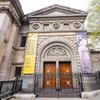More about Queen Elizabeth I ('The Ditchley portrait')

Sr. Contributor
Queen Elizabeth I wears flowers in her hair at Woodstock.
This is kind of like a postcard from the original Woodstock... Woodstock 1592, that is! (Why? which one did you think we meant?). In 1592, Sir Henry Lee entertained Queen Elizabeth I at his Ditchley estate in Woodstock, Oxfordshire. As a former Queen’s Champion, he had arranged jousting matches for Elizabeth, and he knew how to put on a show. The crowning piece of the two-day festivities was a spectacular pageant of noble portraits, climaxing with this massive, life-sized portrait of Elizabeth wearing one glamorous circus tent!
Why all the razzle dazzle? Sir Henry was kissing a little butt to get back in the Queen’s good graces. He had been a royal favorite for over 30 years, but when he retired from court to live in sin with his mistress Anne Vavasour, Elizabeth was not amused. Anne was hardly a respectable choice; a fallen Maid of Honour who had done time in the Tower of London, inspired several duels, had multiple lovers, two bastards, and two husbands at the same time. Sir Henry commissioned this portrait and put on the lavish entertainment at Ditchley in the hopes of burying the hatchet. Elizabeth was duly impressed, and forgave him for becoming a “stranger lady’s thrall.”
Forgiveness is the central theme of the portrait. The Latin phrases read, “She gives and does not expect... She can but does not take revenge... In giving back she increases.” Sir Henry also composed a sonnet for the Queen, visible on the right. Some genius decided to trim down the portrait at one point, cutting off part of the sonnet. The general idea is the glory of “The prince of light” or the sun, an allegory for Elizabeth. Even with the sloppy crop job, it is the biggest known portrait of the Queen.
Elizabeth is literally standing on top of the world (subtle), specifically over Oxfordshire where the ceremonies took place. There’s a storm behind her (her feud with Sir Henry), and sunny skies ahead (their renewed friendship). Sunbeams used to be visible, but the painting is so badly damaged that you can only see them with infrared light.
Until the National Portrait Gallery acquired this painting in 1932, it continued to reside at Ditchley. The estate was once an ancient Roman villa and later home to Winston Churchill, and a location for "The Young Victoria" (2009) and "Downton Abbey" (2015). An interesting former home for an interesting portrait!
Sources
- “Queen Elizabeth I (‘The Ditchley Portrait’),” accessed March 3, 2017, http://www.npg.org.uk/collections/search/portraitConservation/mw02079/Q…
- Kathy Lynn Emerson, “A Who’s Who of Tudor Women: U-V,” accessed March 3, 2017, http://www.kateemersonhistoricals.com/TudorWomenU-V.htm
- Steven W. May, “Vavasour, Anne (fl. 1580-1621),” Oxford Dictionary of National Biography (Oxford University Press, 2004), http://www.oxforddnb.com/index/68/101068083/
- Ed. Regina Schulte, The Body of the Queen: Gender and Rule in the Courtly World, 1500-2000 (New York, Oxford: Berhahn Books, 2006), 71.
- Jennifer Sherwood and Nikolaus Pevsner, Oxfordshire: The Buildings of England (Harmondsworth: Penguin Books, 1974), 576.
- “History Lives at Ditchley and Bletchley -- The Churchill Centre, Archived October 16, 2006 at the Wayback Machine, http://www.winstonchurchill.org/?
- “The Young Victoria film locations,” accessed March 3, 2017, https://movie-locations.com/movies/y/YoungVictoria.html#.WLpOohiZOu4
- “Downton at Ditchley,” September 23, 2015, http://www.ditchley.co.uk/news/post/162-downton-at-ditchley











